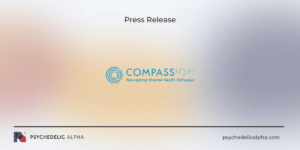— Model is predictive for human efficacy for binge eating —
— BMB compound reduced binge eating in rats with a clear dose range for efficacy —
— A virtual presentation discussing the findings is tentatively scheduled for Wednesday, March 10th at 11:00AM EST —
VANCOUVER, British Columbia, March 03, 2021 (GLOBE NEWSWIRE) — Bright Minds Biosciences (“Bright Minds,” “BMB” or the “Company”) (CSE:DRUG), is focused on developing novel transformative treatments for neuropsychiatry disorders, epilepsy and pain, today announced that studies conducted with its BMB proprietary 5-HT2C agonists show efficacy in rodent models of binge eating.
“These early positive results are very encouraging and represent an important step forward, as we work to unlock the potential of our proprietary compounds. Binge eating disorder (“BED”) in young adults has increased significantly during the pandemic. Existing therapeutics have well-known limitations, and according to National Eating Disorder Association data, 57% of people with BED never receive pharmacological treatment. We look forward to continuing our investigation and addressing this widespread unmet medical need,” stated Ian McDonald, Chief Executive Officer of Bright Minds.
“There is great need to improve treatment of binge eating disorder, and Bright Minds has an innovative new medication candidate to suppress food intake, especially high-caloric palatable foods,” stated Dr. Kathryn A. Cunningham, Center for Addiction Research, University of Texas Medical Branch.
Study Design and Preclinical Findings
The study was directed by leading researcher, Dr. Kathryn A. Cunningham, Director, Center for Addiction Research, University of Texas Medical Branch. The binge eating rodent study used a validated rat model where rodents were habituated to a high fat feeding paradigm. In particular, this rodent model displays the objective characteristics of a binge eating episode, in humans, with consumption of a large amount of high fat palatable food in a short period of time, but also the characteristics of loss of control during the episode. This model is predictive for human efficacy for compounds designed to control binge eating.
The proprietary BMB compound is a novel well characterized 5-HT2C agonist with no 5-HT2A or 5-HT2B agonist activity. Using lorcaserin as the reference compound, the BMB compound was tested at a range of potentially clinically relevant doses, and found to be comparable. Lorcaserin is a well characterized 5-HT2C agonist originally approved for the treatment of obesity, previously demonstrated to suppress binge eating behavior in this rodent model, and no longer on the market.
The BMB compound reduced binge intake to a similar extent as lorcaserin reduction. There was a clear dose response with the highest doses tested showing an approximate reduction in binge eating by 50%. This reduction in binge eating was accompanied by significant decreased body weight during the 24-hour evaluation period.
A virtual presentation to discuss the findings is tentatively scheduled for Wednesday, March 10th at 11:00AM EST.
Link for registration
https://app.livestorm.co/bright-minds-biosciences/binge-eating-disorder-study-presentation?type=detailed
About Binge Eating Disorder
Binge eating disorder is a severe, life-threatening and treatable eating disorder characterized by recurrent episodes of eating large quantities of food (often very quickly and to the point of discomfort); a feeling of a loss of control during the binge; experiencing shame, distress or guilt afterwards; and not regularly using unhealthy compensatory measures (e.g., purging) to counter the binge eating. It is the most common eating disorder in the United States with a lifetime prevalence of 2.8% in females and 1% in males.”
https://www.nationaleatingdisorders.org/learn/by-eating-disorder/bed
Serotonin Agonists and Binge Eating Disorder and Opioid Use Disorder
Central serotonin systems have long been associated with the control of ingestive behavior, and the modulation of behavioral effects of psychostimulants, opioids, alcohol, and nicotine. 5-HT2C receptor agonists likely act directly on these hypothalamic circuits to alter metabolic aspects of feeding, as well as act on the pre-frontal cortex and ventro-tegmental area to control feeding behavior. 5-HT2C agonists also have a broad role in the reduction of drug seeking behaviors via altering neurocircuits and so have the potential to treat substance use disorders (Higgins and Fletcher).
About Bright Minds
Bright Minds is focused on developing novel transformative treatments for neuropsychiatry disorders, epilepsy and pain. Bright Minds has a portfolio of next generation serotonin agonists designed to precisely target abnormalities in neurocircuitry that lead to dysfunctional behaviors. The Company is developing targeted therapies with the potential to improve the treatment of mental health and neurological disorders through the use of serotonergic compounds leveraging its world class scientific and drug development expertise to bring forward the next generation of safe and efficacious drugs. Bright Minds drugs extenuate the therapeutic aspects of psychedelic and other serotonergic compounds while minimizing the side effects thereby creating superior drugs to first generation compounds, such as psilocybin.
Forward Looking Statements
This news release contains forward-looking statements, including statements regarding the scientific findings of Company’s drug development program, and other statements that are not historical facts. Forward-looking statements are often identified by terms such as “will”, “may”, “should”, “anticipate”, “expects” and similar expressions. All statements other than statements of historical fact included in this release are forward-looking statements that involve risks and uncertainties. There can be no assurance that such statements will prove to be accurate and actual results and future events could differ materially from those anticipated in such statements.
The reader is cautioned that assumptions used in the preparation of any forward-looking information may prove to be incorrect. Events or circumstances may cause actual results to differ materially from those predicted, as a result of numerous known and unknown risks, uncertainties, and other factors, many of which are beyond the control of the Company, and which are described in the Company’s public filings available under its profile at www.sedar.com. The reader is cautioned not to place undue reliance on any forward-looking information. Such information, although considered reasonable by management at the time of preparation, may prove to be incorrect and actual results may differ materially from those anticipated. Forward-looking statements contained in this news release are expressly qualified by this cautionary statement. The forward-looking statements contained in this news release are made as of the date of this news release and the Company does not intend to update any of the included forward-looking statements except as required by Canadian securities laws.






